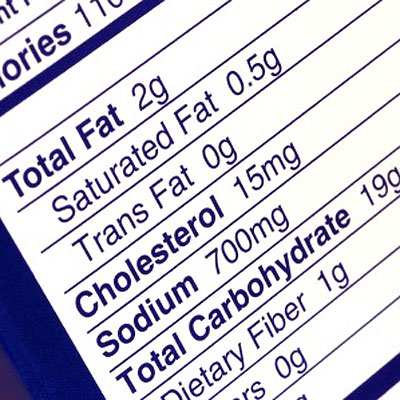The fibro-food connection
By Mara Betsch
Fibromyalgia is notoriously difficult to treat. Medication tends to reduce muscle pain, fatigue, and other symptoms of the chronic condition by just 30% to 50%. As a result, many patients turn to diet and lifestyle changes for added relief.

Learning which foods to avoid is a good place to start, since fibro patients often have food sensitivities that may not show up in food allergy tests. In one survey, 42% reported that certain foods made their pain and stiffness worse.
How does food affect pain?
Experts believe that oversensitive nerve cells in the spinal cord and brain may be involved in the way fibro patients process pain. Certain foods may trigger the release of neurotransmitters that heighten this sensitivity, says Daniel Arkfeld, MD, a rheumatologist at the University of Southern California's Keck School of Medicine.

Although the research on diet and fibromyalgia is limited, experts suggest that the following 10 healthy eating rules can’t hurt, and may help people dealing with chronic pain.
1. Eat more fresh foods
Roughly half of fibro patients also suffer from irritable bowel syndrome (IBS). Eating a diet of fresh foods, devoid of preservatives and additives, may ease fibro symptoms associated with IBS, says Dr. Arkfeld. "Foods that irritate your bowel will trigger the body to send a message to the brain that signals fibromyalgia symptoms," he explains.

Whenever possible, it’s also a good idea to buy organic food. “Some patients do better avoiding pesticides and chemicals,” says Dr. Arkfeld.
2. Don't OD on caffeine
Fibromyalgia is believed to be linked to an imbalance of brain chemicals that control mood, and it is often accompanied by unrestful sleep and fatigue. Fibro patients may try to ease fatigue with stimulants like caffeine, but they may end up doing more harm than good in the long run.

“Caffeine is a loan shark for energy. We recommend not using a lot,” says Kent Holtorf, MD, founding medical director of the Fibromyalgia and Fatigue Centers, which are located across the country.
3. Steer clear of some veggies
"For joint pains, a lot of people say avoid nightshade vegetables," says Dr. Arkfeld. Normally, veggies are low-cal, healthy options, but the nightshade variety—including tomatoes, potatoes, and eggplants—are believed to aggravate arthritis and pain in some people.

"The thought is that they have components that are neurotoxins," says Dr. Holtorf. "For a small percentage of patients, cutting them out makes a dramatic difference."
4. Get plenty of omega-3s
Omega-3 fatty acids, found in salmon and a variety of fish, have been touted as a heart-healthy food, and they may help with pain as well. "The fatty acids are great," says Dr. Holtorf. "They reduce the inflammation and help brain function."

A 2006 survey of arthritis patients found that daily fish oil supplements reduced pain symptoms in 60% of the patients. Omega-3s have not, however, been tested on fibromyalgia patients specifically.
5. Easy on the yeast
Yeast, along with its partner in crime, gluten, can be found in a variety of baked goods. Consuming yeast may contribute to the growth of yeast fungus in the body, which can add to pain, says Dr. Holtorf.

Fibromyalgia patients may also be more prone to gluten sensitivities. "Celiac disease is seen in a subset of patients. Avoiding [yeast and gluten] can help some patients improve," says Dr. Arkfeld.
6. Don't eat too much dairy
Some degree of lactose intolerance affects about 70% of adults worldwide, so it's not surprising that many fibromyalgia patients have trouble digesting dairy products.

In a 1998 study, researchers tested whether blood samples taken from 40 fibromyalgia patients reacted to substances found in various foods; the blood of 25% of the subjects demonstrated an immune response to cow dairy products.
Fibro patients on vegan diets have also seen their symptoms improve.
7. Cut back on carbs
"If I had to choose one particular diet for fibromyalgia patients, I would choose a low-carb, low-sugar diet," says Dr. Holtorf.

"About 90% of fibromyalgia patients have low adrenal functioning," he adds, which affects the metabolism of carbohydrates and may lead to hypoglycemia. These people crave sugar, but they also experience the crash that follows the initial energy high. "If you're hypoglycemic, you want to keep that sugar level as stable as possible. Try carbs with a mix of protein and fat," says Dr. Arkfeld.
8. Ease up on aspartame
"Getting off [aspartame] can make some pain patients feel much better," says Dr. Holtorf. The artificial sweetener found in diet sodas and many sugar-free sweets is part of a chemical group called excitotoxins, which activate neurons that can increase sensitivity to pain. Though aspartame isn’t dangerous to healthy people when consumed in moderation, it may heighten fibro patients' sensitivity to pain.

Some artificial sweeteners, most notably sorbitol and xylitol, can trigger IBS as well.
9. Avoid additives
Food additives such as monosodium glutamate (MSG) often cause trouble for pain patients. MSG—a high-sodium flavor enhancer often added to fast food, Chinese food, and processed packaged foods—is a an excitatory neurotransmitter that may stimulate pain receptors; glutamate levels in spinal fluid have been shown to correlate with pain levels in fibromyalgia patients.

A 1995 report commissioned by the U.S. Food and Drug Administration stated that MSG may cause short-term reactions such as headaches, and a 2007 animal study in the journal Pain suggested that increases in glutamate in muscles may contribute to pain sensitivity.
10. Say no to junk food
The National Fibromyalgia Research Associationrecommends limiting or eliminating refined sugar, caffeine, fried foods, and highly processed foods—in other words, most fast food, candy, and vending-machine products. In addition to contributing to weight gain, these foods may irritate muscles, disrupt sleep, and compromise the immune system.

Experimenting with an elimination diet and cutting the foods in this slideshow out completely for several weeks—either one at a time or all at once—may help you decide whether they affect your fibromyalgia symptoms.
From:

No comments:
Post a Comment